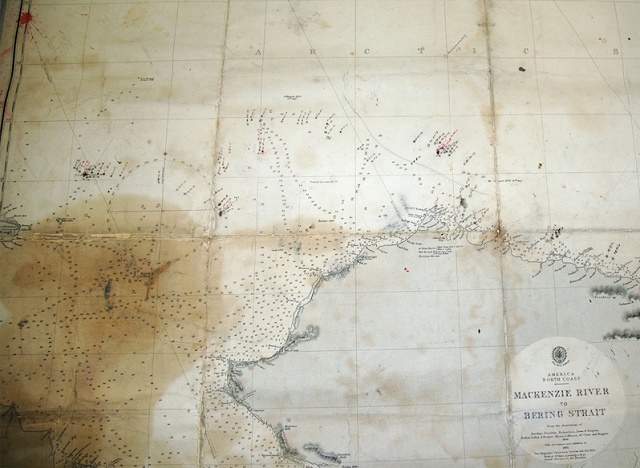Museum Discovers Century-Old Record of Ship's Sinking
The Peary-MacMillan Arctic Museum has determined that a chart donated to the museum is the one on which ice captain Robert A. Bartlett recorded the disastrous 1914 Arctic expedition of the Karluk ship.
The Karluk was carrying scientists and explorers along the north coast of Alaska when it became trapped in pack ice and began to drift north and west. Several months later, the ship sank.
When the chart arrived at the museum, it was unidentified and came in a large envelope that had been unopened for many years. The document was donated — along with dozens of miscellaneous papers, photographs, and artifacts — to the museum in 2012 by the family of William James (“Jim”) Dove, who was a nephew of Bartlett’s.
The museum’s curatorial staff examined the chart and noticed annotations of locations and dates. They realized that they corresponded with the drift and sinking of the Karluk, so they compared the document to a chart illustrated in Bartlett’s published account of the disaster. Soiled areas, a major tear and fold patterns are all identical. They concluded that the document is the original chart that Bartlett marked up while on the Karluk and carried with him during his subsequent journey over the ice and down the east coast of Siberia.

The museum has received a grant from Kane Lodge Foundation, Inc. to conserve and display this historically significant piece of Arctic exploration history.
The Karluk’s final journey
Vilhjamur Stefansson, head of the Canadian Arctic Expedition, leased the Karluk — a 247-ton, 126-foot long retired whaling ship — in 1913 to sail to the Arctic and discover new islands to claim for Canada. He asked Bartlett to serve as captain of the vessel.
Bartlett was a Newfoundland ship captain famous for his ability to navigate through ice. In 1905-06 and 1908-09 he was captain of the SS Roosevelt, Robert E. Peary’s North Pole expedition vessel.
On August 3, 1913, the Karluk became stuck in thick ice off the coast of northern Alaska. By September 18 it was evident that the vessel, now frozen in a massive ice floe, would not be free until the spring. Stefansson took a hunting party ashore, leaving Bartlett in charge of 24 scientists and crew, including five Alaskan Iñupiat. Within days of Stefansson’s departure the ice surrounding the Karluk began to drift north into the Arctic Ocean and then west toward Siberia, carrying the vessel with it. Bartlett, realizing that the Karluk would inevitably be crushed by ice, urged his passengers to use food crates to make a shelter on the ice and to build sledges on which to haul food and supplies.
On December 26, after over three months of drifting, the Karluk began to shudder under the strain of ice pressing against its wooden hull. On January 10, 1914, ice pierced the ship’s planking and water flooded the engine room; the Karluk could not be saved.
Bartlett ordered the passengers and crew off the ship and they moved 10,000 pounds of supplies onto the ice next to the crate house. The next day Bartlett gathered up his charts and stepped off the ship. A few hours later the Karluk sank.
After two months living on drifting ice Bartlett led the shipwrecked group to the uninhabited Wrangel Island, off the north coast of Siberia. Eight men were lost in the process. Then Bartlett and Kataktovick, an Iñupiat man, crossed over shifting ice to Cape North, Siberia. For the next six weeks they traveled southeast in search of a wireless station so they could launch a rescue mission. On May 29, Bartlett was finally able to send the message asking for help. The rescue of survivors from Wrangle Island took place on August 23, 1915. While the reunion was joyful, Bartlett was saddened to learn that three men had died during the nine months it took Bartlett to return to Wrangel Island with help.
Over the next three decades Bartlett continued to sail north, most often at the helm of his own vessel, the Effie Morrissey, now known as the Ernestina, based out of New Bedford, Mass. In 1920, Bowdoin gave Bartlett an honorary degree for his involvement in Peary’s North Pole expeditions.
The Kane Lodge Foundation, Inc. is named for Elisha Kent Kane, one of America’s first Arctic explorers. Its membership is the same as Kane Lodge, No. 454, F.& A.M., a Masonic Lodge that counted Robert E. Peary and Donald B. MacMillan as members.
